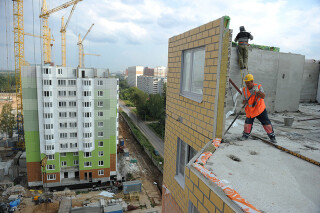While Russian drones are busily creating a pipeline of reconstruction work for neighbouring Ukraine, spare a thought (perhaps) for Russia’s own construction companies, paralysed by international sanctions and an acute shortage of materials and equipment.
The Russian construction sector is facing the deepest crisis in its history with the ongoing war with Ukraine and unprecedented sanctions leading to a sharp drop in output and the suspension of many large-scale projects.
Prior to 24th February 2022, Russia’s construction industry was among the fastest-growing in Europe. The industry received a massive surge in growth in the run-up to Russia’s hosting of the Fifa World Cup in 2018, peaking at more than 12% per annum. And until this year, the Russian government had a target of 120 million square metres of new housing per year to 2030 – one of the most ambitious in Europe.
But the assault on Ukraine and the resulting deep isolation of Russia on the international stage has had a catastrophic effect on the country’s construction sector.
According to a recent report published by Synergy, a Russian trade association in the field of construction and design, the economic crisis created by the war has resulted in 40% of regional construction companies freezing projects and delaying their completion indefinitely.
A sharp rise in the cost of building materials and the lack of finance are the main problems. As a result, the total volume of housing starts is projected to fall by 20% this year while the number of new commercial construction projects will fall by 40%.
Undoubtedly the biggest problem for the industry is the high cost of building materials. Since the beginning of the year, materials costs on the Russian market have increased by an average of 50%. For some items, prices have doubled.
Price hikes slowed somewhat during the summer but the current unstable situation in the market continues to cause big problems. That has had a negative effect on the volume of housing completions which have already dropped by more than 30% since 2021.
According to 33 online, a Ulyanovsk-based construction magazine, the industry currently remains heavily dependent on imported raw materials and equipment. Historically, domestic manufacturers have been able to provide the Russian market with a limited range of construction materials such as cement, brick, wood, crushed stone and steel.
But an estimated 70% of construction chemicals, insulation products and other light-side products are normally imported, mostly from the EU.
Russia’s deputy prime minister Marat Khusnullin, who is also the minister for construction and regional development, said in a recent interview: “The Russian construction sector will not receive anything from the EU in the foreseeable future, which means that the government will have to stimulate the production of the necessary construction materials within Russia.”
But Russia is not in a good position to start up domestic production of many important building products. This is because most of the necessary raw materials – pigments and chemicals for plaster and paints, resins and adhesives for laminate, chemical components for wallpaper, dyes for ceramic tiles and glaze for sanitary ware – are also imported.
Russia also lacks enough of its own specialist M&E suppliers. In the case of lifts and elevators, the exodus of all the major global suppliers from the Russian market, including Otis, Kone and Schindler, has dealt a big blow to the Russian construction industry.
Finding alternatives to such systems is especially difficult because buildings are often designed to accept a specific manufacturer’s product. Procuring or re-engineering an alternative takes time and adds cost.
Where domestic alternatives are available, prices have rocketed in response to demand. Recent data from the Russian federal statistics service, Rosstat, shows that prices for building materials have risen by almost 30%, finishing materials by 48%, while the price of machine tools and engineering equipment has increased by about 43%.
Some analysts believe that domestic materials producers have taken advantage of the current situation by raising prices despite the fact that their product range is usually limited and the quality of their products is sometimes significantly lower than those of imported equivalents.
Furthermore, the volatility of the materials and equipment supply chains is such that suppliers are trying to protect themselves by demanding advance payments and refusing to set prices.
Russian developers have reported that the ever-growing price of construction materials and the shortage of equipment has meant that even projects that were close to completion have stalled this year.
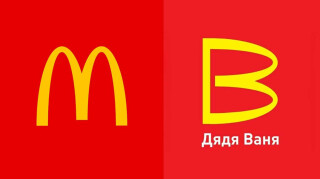

Khusmullin has also called on domestic developers to pursue contracts for the supply of building materials and equipment with Asian manufacturers – despite the fact that most Asian suppliers, including China, are strongly disinclined to replace their Western competitors in Russia because of the widespread sanctions that have been imposed.
Possible alternative sources include friendly states such as Belarus and Kazakhstan. But here the biggest challenge is to find a worthy replacement and maintain the quality of the final project. Russian buyers can expect longer delivery times when sourcing supplies from Asian and post-Soviet states and, in turn, suffer serious delays in the commissioning of new projects.
The Russian government is of course aware of the problems its war has inflicted on the construction industry and is desperate to find ways to mitigate the damage – short of ceasing hostilities and getting out of Ukraine, of course.
Among the measures proposed by the state is a moratorium on the imposition of financial penalties for late project completions and the extension of existing building permits for one year. It has also announced zero import duties on the supply of some imported building materials, products, equipment and machinery in a bid to keep foreign goods trickling in.
But despite this state intervention, many construction clients have been forced to revise their financial calculations, according to Forbes Russia. Already many housing developers have said that previously approved project finance packages will not be enough to complete current projects.
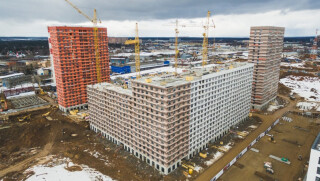
This problem remains pressing not only for housing construction, but for all sectors of the Russian construction industry. Many clients and their contractors are now desperately seeking ways to reduce construction costs as funds, initially issued under loan agreements, become insufficient to complete projects.
Unsurprisingly, the economic impact of Putin’s war on Ukraine has had a chilling effect on demand for construction work. Anton Glushkov, president of Russia’s National Association of Builders was recently quoted in the Vedomosti business paper that western sanctions have resulted in a sharp reduction in demand for new housing and a corresponding increase in the cost of project funding.
“Due to declining purchasing power of local customers, the number of potential buyers has significantly decreased. This is already evident in the statistics of mortgage lending,” said Glushkov.
According to some Russian market sources, the monthly volume of mortgage loans has fallen by two-thirds this year compared with 2021.
More than 80% of housing in Russia is financed through an escrow account mechanism designed to guarantee the safety of buyers’ funds. But amid the current situation this mechanism has become extremely vulnerable to the rising prices of construction materials and the disruption of supply chains.
In the commercial property sector, retail looks set to be the hardest hit as this market is highly dependent on western customers. The development of new shopping centres – until recently a very buoyant market – faces the biggest decline. The number of new shopping centres opening in Russia this year will be insignificant, thanks to a massive withdrawal of leading foreign retail brands from the country.
The Russian Ministry of Construction has said that the situation in the industrial construction market is also perilous and construction volumes here will fall by 50% this year.
So the outlook for construction, like so many other sectors of the Russian economy, is challenging, to say the least. If there is any segment of the industry that might show some growth this year it will be state-funded construction. And most of it will probably be associated with military infrastructure.
Bridge over troubled waters
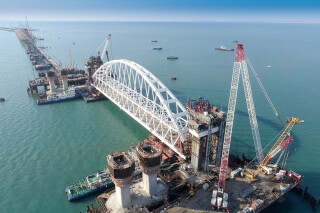
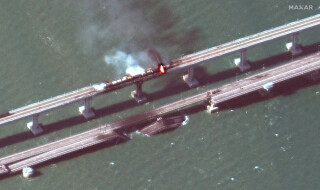
Perhaps the most powerful expression of Russia’s construction prowess is the Crimea Bridge, built across the Kerch Strait to connect Russian-occupied Crimea with the Russian territory of Krasnodar Krai.
The 19km-long bridge, completed in 2018 at an estimated cost of around US$4bn, was not merely a major piece of transport infrastructure but also a symbol of Russia’s determination to grab Ukrainian territory.
It was therefore no coincidence that Ukrainian special forces chose to target the bridge in October 2022 following Russia’s military assault on Ukraine – although Ukraine has not officially claimed responsibility for the bombing. It was also probably not a coincidence that the attack happened the day after president Vladimir Putin’s 70th birthday.
The explosion, which was caught on CCTV, destroyed two two-lane vehicular spans, damaging two more lanes and the railway track. Four people died.
The repair and reconstruction of the damaged bridge is estimated to provide work for Russian contractors until at least September 2023.
Got a story? Email news@theconstructionindex.co.uk

